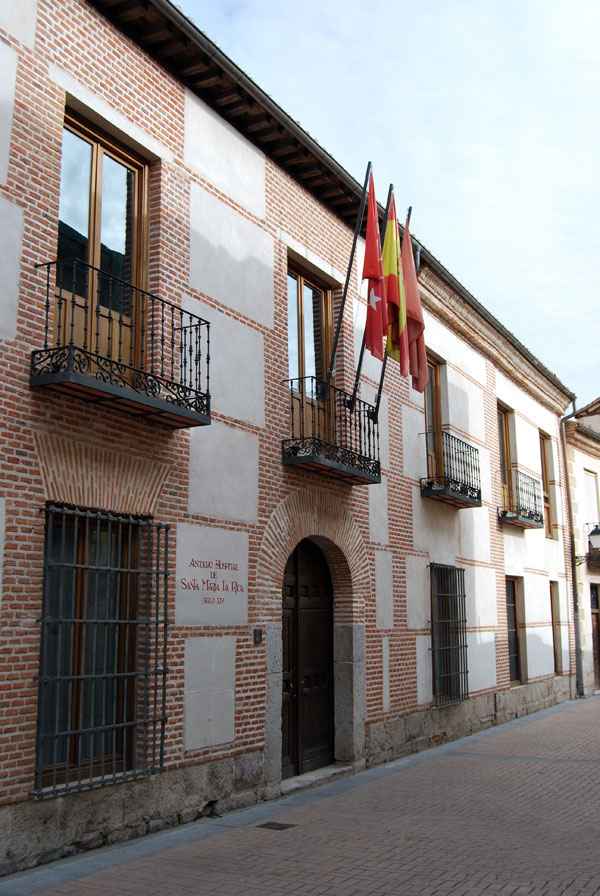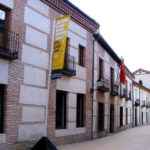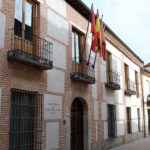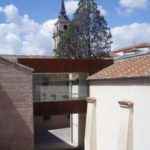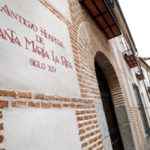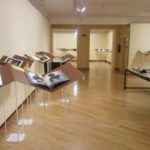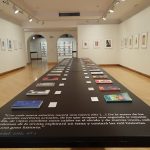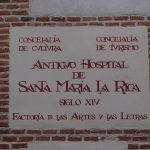Este texto también está disponible en español
Santa María la Rica Hospital is the Alcalá’s oldest charitable institution. Today, it is an important cultural center with outstanding and continuous expositions, such as the annual PhotoEspaña.
Santa María la Rica Hospital took care and sheltered poor people and pilgrims up to nineteenth century. After that, the building came into several usages, until finally; it turned from being a Police Station to a modern and very active exposition hall in 2000.
Santa María la Rica Hospital was founded by a rich married couple—Pascual Pérez and his wife Antonia—in the late thirteenth century and beginning of the fourteenth; becoming Alcalá de Henares’ oldest charitable institution. The hospital was devoted to healthcare until the first quarter of nineteenth century, when it was substituted by a charity house and a preventive detention prison. It is situated at the back of the Magisterial Cathedral, in a small street with the same name. The institution never was actually built up, but several houses were donated and gathered together by the institution founders.
After the Pérez couple death, in 1312, their assets and the Santa María la Rica Hospital itself went on to be ruled by the Santa María Brotherhood, in which the elite of Alcalá’s society was represented by clergy, nobility and local bourgeoisie members. The main brotherhood charges were: provost, mayor, butler and caretaker.
The Santa María la Rica Hospital also had a surgeon barber—similar to current nurses—as well as a court clerk and a chaplain who belonged to the San Justo church, the current Magisterial Cathedral. The extensions and reforms to the original brotherhood constitutions—where its functioning is fixed—are still hold, from 1391, into the Municipal Archive.
Healthy people, three days
Santa María la Rica Hospital took care of pilgrims and wayfarers both healthy and sick who were passing through. The curious thing is that, healthy wayfarers could just stay three nights in the hospital if they were men, and five in case of women.
Sick people tough had the right to spend more time in, until their healing, and there were precise rules to take care of them such as: the caretaker should wake up at least once a night and leave a candle by his side, a lamp should burn at the side of his bed and, of course, he should be confessed and have received communion.
The rich brotherhood
Both Santa María la Rica Hospital and the brotherhood ruling it had a wealthy economic situation—thanks to the considerable inherited assets of Pérez family and to the high annual shares members who wanted to be part of the brotherhood should pay. All this contributions made it possible to continue enjoying a comfortable situation until the middle of twelfth century, when the hospital fell into a decline from which it never was recovered. In 1740, the brotherhood was extinguished and the hospital changed its name to that of San Juan de Letrán, barely subsisting until the end of nineteenth century, when Santa María la Rica Hospital houses were allocated to other usages.
The usages of the houses have been diverse: prison, Civil Guard headquarters, storehouse, fire station and finally Municipal Police Station. A renovation was undertaken at the year 2000, though several original elements such as the façade, the church, a Mudéjar fifteenth-century coffered ceiling and some old backyard columns were kept. Several Hispano-Flemish paintings held in the City Council are still preserved today.
Large expositions
After the renovations, Santa María la Rica Hospital has become an important cultural center with outstanding and continuous expositions such as the annual PhotoEspaña or the Madrazo painters collection—José Madrazo and Federico Madrazo—, now in the permanent custody of Alcalá’s City Council. Interesting expositions are available to visit during almost all year.
Additional information:
- Aspects of Alcalá de Henares caring of poor people; brotherhoods and hospitals in Early Middle Ages.
- Allaboutmadrid.com
- Alcalavirtual.es
Useful information:
- Address: Calle Santa María la Rica, 3
- Telephone: +34 91 887 32 53
- Opening hours T-S: 10:00 a.m. to 2:00 p.m. and 5:00 p.m. to 8:00 p.m.
- Mondays closed
Access from Madrid
- Renfe Cercanías railroads C-1, C-2 and C7A.
- Bus nº 223 (departure from Avenida de América Interchanger).
Image gallery:
Where is it
Sigue disfrutando de Dream Alcalá:
- Telegram: Recibe nuestras noticias y contenido exclusivo (clic aquí).
- Newsletter: Recibe cada tarde un correo con nuestras últimas noticias (clic aquí).
- YouTube: Suscríbete para ver nuestros mejores vídeos (clic aquí).
 Sé tú el periodista: envíanos tus fotos o noticias a través de Telegram.
Sé tú el periodista: envíanos tus fotos o noticias a través de Telegram.

